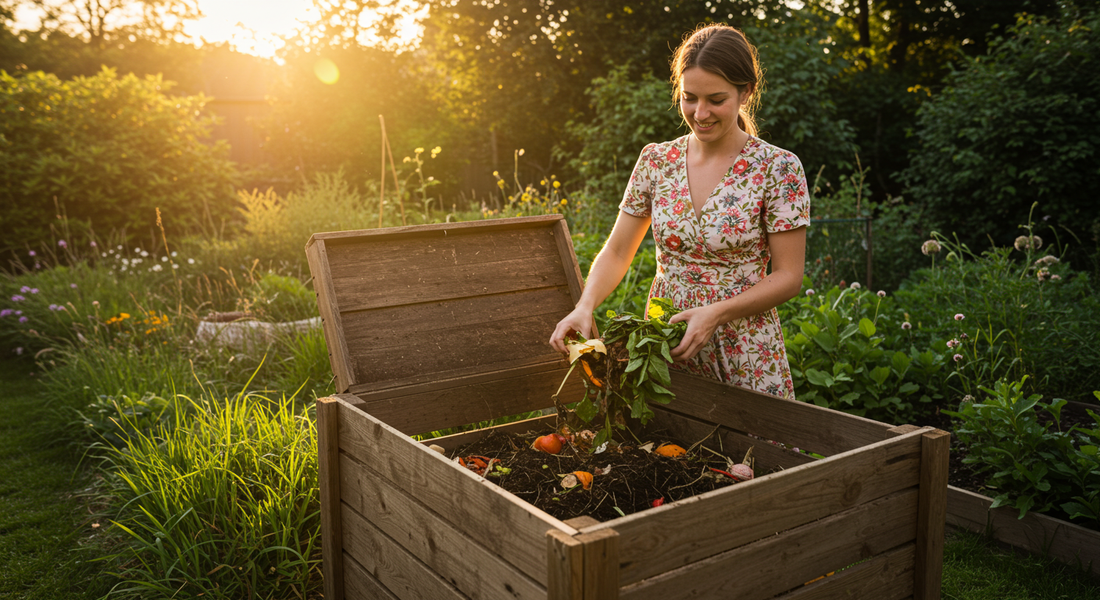
Composting for Beginners: How to Turn Kitchen Scraps into Black Gold
Share

Every year, households throw away a staggering amount of food scraps and yard waste. But what if you could turn that "waste" into the most valuable resource for your garden? That's the magic of composting. Backyard composting is the ultimate recycling program, a simple process of transforming kitchen scraps and yard trimmings into "black gold"—a rich, nutrient-dense fertilizer that will make your garden thrive. Best of all, it's easier than you think. Forget the common myths that composting is complicated, smelly, or difficult. This guide on how to start composting will show you how simple and rewarding it can be.
Choosing Your Composter
Your first big decision is what kind of compost bin for beginners to use. Your choice will likely depend on your space, budget, and how hands-on you want to be.
-
Compost Tumblers: These are enclosed bins that are mounted on an axle, allowing you to easily turn and aerate the contents by rotating the entire drum.
-
Pros: They are tidy, keep pests out, and can produce finished compost relatively quickly due to easy aeration.
-
Cons: They have a limited capacity and can be more expensive upfront.
-
-
Compost Bins: These can be purchased or easily built from wood pallets or wire. They are stationary, open-topped containers that hold your compost pile.
-
Pros: They are cost-effective and can hold a larger volume of material.
-
Cons: Turning the pile with a pitchfork requires more physical effort.
-
-
Open Piles: The simplest method is a free-standing pile in a corner of your yard.
-
Pros: It's free and can be as large as you need.
-
Cons: It can be less tidy and may be more attractive to pests if not managed properly.
-
The Golden Ratio: "Greens" and "Browns"
A healthy compost pile requires a balanced diet. The key is to maintain a good ratio of nitrogen-rich "green" materials and carbon-rich "brown" materials. A good rule of thumb is to aim for roughly two to three parts browns to one part greens.
-
What are "Greens"? (Nitrogen): These are the wet, fresh materials that provide nitrogen. Think of:
-
Fruit and vegetable scraps
-
Coffee grounds and tea bags
-
Fresh grass clippings
-
Eggshells (crushed)
-
-
What are "Browns"? (Carbon): These are the dry, woody materials that provide carbon and add bulk. Think of:
-
Dry leaves
-
Shredded cardboard and newspaper (not glossy)
-
Twigs and small branches
-
Sawdust from untreated wood
-
-
What to NEVER put in compost: To avoid odors, pests, and pathogens, never add:
-
Meat, fish, or bones
-
Dairy products or grease
-
Pet waste (dog or cat feces)
-
Diseased plants
-
Maintaining Your Compost
Once your pile is started, maintaining it is simple. It just needs two things: moisture and air.
-
Moisture: Your compost pile should feel like a wrung-out sponge—damp, but not soaking wet. If it's too dry, add some water with a hose. If it's too wet (often from too many greens), add more brown material.
-
Aeration: Your compost needs oxygen for the beneficial microbes to do their work. If you have a tumbler, give it a few spins every few days. If you have a bin or pile, use a pitchfork or compost aerator to turn the pile once a week. This mixes the materials and prevents compaction.
-
When is it Ready? Your compost is finished when it is dark, crumbly, and has a rich, earthy smell. This can take anywhere from a few months to a year, depending on your method and maintenance.
Conclusion: Closing the Loop in Your Home and Garden
Composting is a deeply rewarding process. It reduces your household waste, lowers your carbon footprint, and provides you with the best all-natural fertilizer your garden could ask for. By turning your kitchen scraps back into nutrient-rich soil, you are closing the loop, creating a more sustainable and self-sufficient home. Start your pile today and watch your garden reap the benefits.
